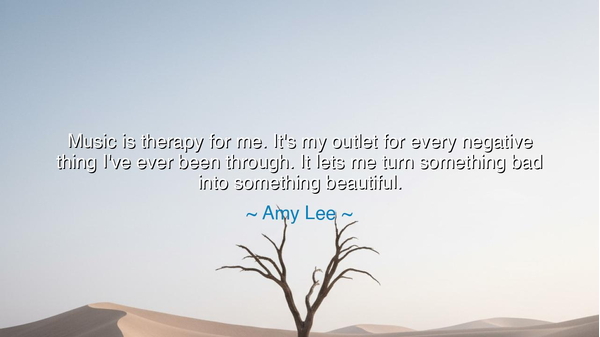
Music is therapy for me. It's my outlet for every negative thing
Music is therapy for me. It's my outlet for every negative thing I've ever been through. It lets me turn something bad into something beautiful.






“Music is therapy for me. It's my outlet for every negative thing I've ever been through. It lets me turn something bad into something beautiful.” Thus spoke Amy Lee, the haunting voice of Evanescence, whose songs echo with sorrow yet rise in majesty. Her words reveal a truth as old as humanity: that music is more than art or entertainment—it is healing, transformation, and alchemy of the soul. For through song, the darkness of suffering may be reshaped into light, and what once wounded may become a gift to others.
The ancients understood this mystery well. Among the Greeks, Orpheus was said to charm even the stones with his lyre, and his songs could soothe grief and restore hope. The psalms of Israel, born of anguish and exile, turned mourning into prayer and despair into hope. In every culture, music as therapy has been honored, for it has the power to carry human pain into a higher realm where it is not destroyed but transfigured. Amy Lee’s voice is but one in a chorus stretching back to the dawn of time.
Her own life and art reflect this alchemy. The music of Evanescence is steeped in themes of loss, grief, and longing. Yet within that darkness, her voice soars, transforming sorrow into something powerful and strangely beautiful. When she sings of despair, it is not to wallow in it, but to lift it into song, where others who suffer may find recognition, comfort, and strength. Thus her pain becomes not only her therapy, but also healing for all who listen.
History gives us countless examples of this transformation. Consider Beethoven, who when struck by deafness, might have surrendered to despair. Instead, he poured his anguish into symphonies of such depth and beauty that they continue to stir hearts centuries later. Or think of Billie Holiday, whose troubled life was transformed into songs like Strange Fruit, which carried not only her grief but the collective sorrow of her people, turning personal pain into a weapon of truth and beauty. Each reminds us, as Amy Lee does, that the artist’s suffering can be transfigured into a gift for the world.
The lesson is profound: when darkness comes, do not bury it in silence. Find your outlet—through music, through art, through words, through creation. For in expressing pain, you rob it of its power to destroy you, and you may even shape it into something that blesses others. To remain silent is to let wounds fester; to create is to turn wounds into wings. Amy Lee teaches that what was once a burden may become a beacon, if only we dare to release it into form.
O seekers of wisdom, let this truth sink deep: suffering is part of life, but what you make of it defines you. Do not let hardship remain as poison in your heart. Instead, pour it into creation, and watch as the bitter becomes sweet, the ugly becomes beautiful, the broken becomes whole. Your pain can be transformed into art, into wisdom, into strength—not only for yourself but for those who walk beside you.
In practice, seek your own therapy in creation. You need not be a great singer or painter; even a simple song hummed, a journal written, or a picture drawn can carry sorrow into light. When you face grief, do not let it drown you in silence—channel it. In doing so, you will discover that beauty can indeed be born from pain, and that your deepest wounds may give rise to your most enduring strength.
Thus Amy Lee’s words endure: music is therapy, an outlet that turns pain into beauty. Carry this teaching into your own life. For though you may suffer, you also carry within you the power to transform, to transmute sorrow into song, and in so doing, to heal not only yourself but the world.






AAdministratorAdministrator
Welcome, honored guests. Please leave a comment, we will respond soon